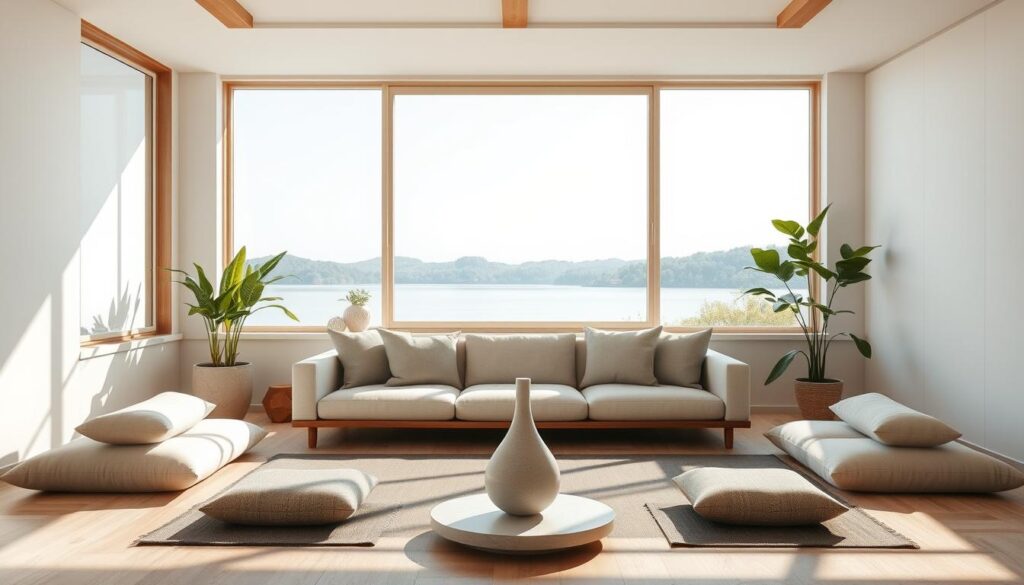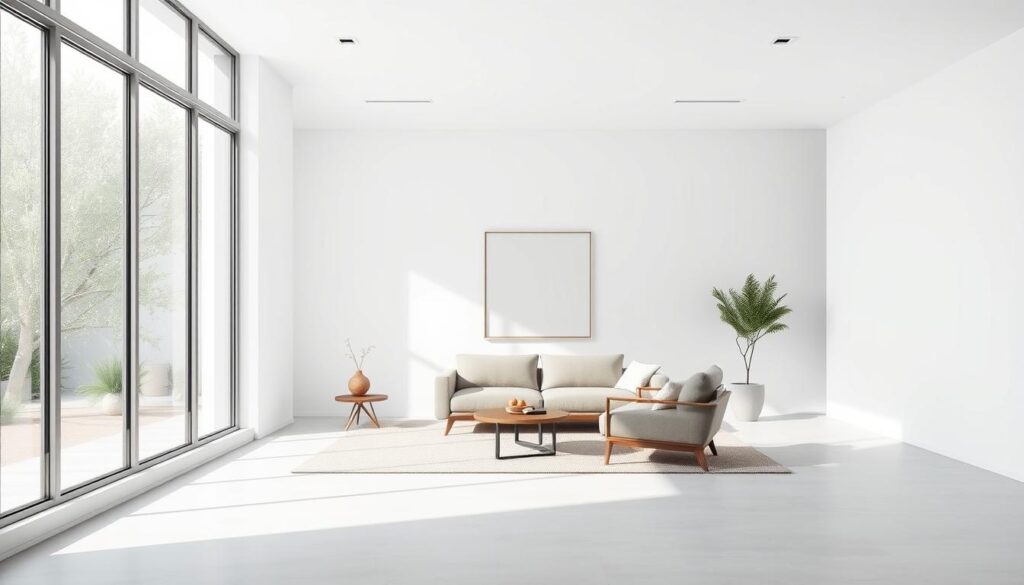In today’s fast-paced world, more people seek calm through thoughtful design. Two popular styles—minimalism and Zen-inspired spaces—promise tranquility but take different approaches. Which one truly fosters peace?
Projects like Japan’s Stairway House and Dharma Drum Mountain’s meditation centers showcase these philosophies in action. Studies suggest both reduce stress, yet their methods vary. One focuses on simplicity, while the other embraces natural harmony.
This article explores how each style uses space, materials, and philosophy to create serenity. Whether you prefer clean lines or organic balance, understanding these differences helps craft your ideal retreat.
Key Takeaways
- Modern design trends emphasize peaceful living spaces.
- Minimalism strips away clutter for mental clarity.
- Zen-inspired spaces blend nature and mindfulness.
- Both styles reduce stress but use distinct methods.
- Real-world examples highlight practical applications.
Introduction to Zen House Aesthetic and Minimalism
Modern homes are becoming sanctuaries from daily chaos. With 72% of Americans stressed by clutter, interior design now prioritizes mental well-being. Two styles lead this movement—one rooted in simplicity, the other in harmony.

Why These Styles Matter in Modern Living
Visual clutter isn’t just messy—it spikes cortisol. Neuroscience reveals crowded living spaces overwhelm the brain. Symptoms of “clutter fatigue” include:
- Difficulty focusing
- Increased anxiety
- Lower productivity
“Keep only what sparks joy. The rest is noise.”
Her KonMari method fueled a 300% rise in professional organizers. It’s proof that mindfulness reshapes how we inhabit spaces.
The Growing Popularity of Peaceful Home Designs
The pandemic turned homes into multipurpose zones. Demand for tranquility surged—ZenWaterPro themes saw a 140% adoption spike. Hybrid work made boho-farmhouse decor trends blend with minimalist function.
From Tokyo to New York, the world embraces designs that balance beauty and calm. Whether through sparse layouts or nature-inspired textures, the goal is the same: a refuge from chaos.
What Is Zen House Aesthetic?
Spaces that calm the mind often draw from centuries-old traditions of balance. This approach blends natural elements with intentional emptiness, creating rooms that feel alive yet uncluttered.

Roots in Japanese and Chinese Traditions
Kyoto’s Ryōan-ji Temple exemplifies this. Its karesansui garden uses raked gravel and moss to mirror nature’s patterns. Similarly, Matsumura Goshun’s 1784 ink paintings capture the essence of quiet landscapes.
Key principles include:
- Wabi-sabi: Tea ceremonies celebrate imperfections like uneven clay bowls.
- Ma: Tatami rooms use negative space to frame movement and rest.
- Ikebana: Flower arrangements balance stems and voids.
The Philosophy of Mindfulness and Harmony
Zazen meditation shapes room layouts—low platforms face gardens to deepen focus. Modern homes like the Polygon House adapt these ideas with sliding screens and indoor pebble gardens.
“In emptiness, everything becomes possible.”
This zen philosophy turns homes into sanctuaries where every corner invites stillness.
What Is Minimalism?
Cutting through noise, this philosophy champions essentials over excess. It’s not just empty rooms—it’s functionality sculpted into clean lines. Studies show minimalist homes slash cleaning time by 63%, proving simplicity saves more than space.

The “Less Is More” Approach
Bauhaus pioneers in the 1950s laid the groundwork. Today, digital nomads embrace tiny homes with convertible walls. Dieter Rams’ 10 principles still resonate:
“Good design is as little design as possible.”
Modern takes include The Zen Home’s foldable desks and Murphy beds—spaces adapt to needs, not the other way around.
Functionality Over Ornamentation
The multifunctional furniture market grows at 38% yearly. Why? Pieces like Nest’s sofa-bed-desk hybrids fit lifestyle demands. Color psychology plays a role too:
| Color Scheme | Effect | Example Use |
|---|---|---|
| Monochromatic | Reduces visual stress | Open-plan offices |
| Neutral tones | Enhances focus | Home studios |
ZenEarthPro’s hidden storage solutions exemplify this approach—drawers under stairs, shelves behind mirrors. Every inch earns its keep.
Zen House Aesthetic vs Minimalism: Key Differences
Balancing serenity and simplicity, two distinct design philosophies offer unique paths to tranquility. One embraces spiritual harmony, while the other prioritizes functional clarity. Let’s explore how they diverge in approach, layout, and material choices.

Design Philosophy: Spirituality vs Practicality
Zen-inspired spaces focus on mindfulness, often incorporating rituals like tea ceremonies. The aesthetics celebrate imperfections—think handcrafted pottery or uneven wood grains. Minimalism, however, strips away distractions to enhance efficiency. Dieter Rams’ principle—“less but better”—guides this utilitarian mindset.
Use of Space: Negative Space vs Decluttering
In zen design, emptiness (or ma) is intentional. Rooms feature asymmetrical layouts, like Stairway House’s staggered platforms. Minimalism opts for geometric precision—think grid-like shelving or floating desks. Both reduce clutter but achieve it differently: one through artistic balance, the other via systematic removal.
Materials: Natural Elements vs Neutral Simplicity
Water Moon Monastery showcases natural materials—stone basins, cedar beams—to connect indoors with nature. Minimalist spaces favor polished concrete or matte metals for a uniform look. Thermal studies show wood retains warmth better than synthetics, yet sleek surfaces simplify cleaning.
| Feature | Zen Design | Minimalism |
|---|---|---|
| Layout | Asymmetrical (tatami zones) | Grid-based (modular furniture) |
| Acoustics | Shoji screens soften sound | Sound-dampening panels |
| Maintenance | Organic textures need care | Wipeable surfaces save time |
Whether drawn to the whisper of bamboo or the hush of a monochrome room, your choice reflects how you define peace.
Key Elements of Zen House Aesthetic
Authentic Japanese design principles transform ordinary rooms into mindful retreats. These spaces use natural materials and sensory details to create harmony. From the citrus scent of hinoki wood to the sound of trickling water, every element serves a purpose.

Natural Materials and Textures
Hinoki cypress ages beautifully, releasing phytoncides that reduce stress. Artisans hand-plane each board to preserve its grain. This traditional wood appears in:
- Shoji screen frames that filter light
- Ofuro soaking tubs that retain heat
- Tansu chests with oxidized iron hardware
Walls often feature gofun pigment made from crushed oyster shells. When mixed with seaweed binder, it creates a luminous finish that changes with daylight.
Muted Color Palettes
Seasonal tones dominate, inspired by nature’s transitions. Spring might bring pale sakura pinks, while autumn suggests mossy greens. Fujimar prints demonstrate this color theory:
| Season | Dominant Hue | Material |
|---|---|---|
| Winter | Slate blue | Indigo-dyed linen |
| Summer | Rice paper white | Washi screens |
“Colors should whisper, not shout. A room’s palette must leave space for contemplation.”
Incorporating Water and Light
Shakkei windows frame outdoor views like living paintings. A small indoor fountain can recycle water through bamboo piping. Maintenance is simple:
- Weekly algae removal with soft brushes
- Seasonal stone cleaning using vinegar solutions
- LED moonlights for evening ambiance
Circadian lighting systems mimic sunrise to sunset. They regulate melatonin using tunable white LEDs. This creates a natural rhythm that supports restful sleep.
Key Elements of Minimalism
The art of subtraction defines truly functional environments. This design philosophy transforms cluttered rooms into efficient spaces where every item serves a purpose. From modular apartments to corporate offices, minimalist principles deliver both beauty and practicality.

Clean Lines and Geometric Shapes
Precision rules in minimalist interiors. Angular sofas meet floating shelves in perfect 90-degree harmony. The ZenLifePro theme showcases this with:
- Parametric shelving that adapts to wall contours
- Sliding doors with hidden magnetic latches
- Hexagonal coffee tables with built-in charging pads
A 400 sq.ft New York studio demonstrates this approach. Custom millwork creates storage within walls, while foldable dining surfaces vanish when unused.
Neutral and Monochromatic Colors
Limited palettes reduce visual noise. Research shows 78% of workers prefer offices with restrained color schemes. Effective combinations include:
| Tone | Material Pairing | Room Application |
|---|---|---|
| Warm gray | Brushed concrete | Kitchen backsplashes |
| Oatmeal | Linen upholstery | Living room seating |
“Color should clarify form, not compete with it.”
Multifunctional Furniture
Innovations maximize functionality without bulk. Antimicrobial kitchen islands now incorporate:
- Retractable cutting boards
- Self-cleaning quartz surfaces
- IoT-enabled temperature zones
Wall beds with integrated desks prove especially valuable in small homes. These space-saving solutions follow the minimalist creed—everything in its place, and a place for everything.
How Zen Design Creates a Sense of Calm
The science behind calming spaces reveals how specific elements reduce daily stress. Studies show views of nature through shoji screens lower cortisol by 40%. This approach blends architectural precision with psychological insights for true tranquility.

The Role of Negative Space (Ma)
Traditional Japanese architecture measures emptiness in ma—the pause between structural elements. The tatami mat system defines these proportions:
| Measurement | Purpose | Psychological Effect |
|---|---|---|
| 1 ken (6 shaku) | Room width | Creates comfortable sightlines |
| 3 shaku gap | Between pillars | Encourages mindful movement |
Engawa transitional spaces demonstrate this principle. These narrow verandas act as buffers between rooms and gardens. Research confirms they help people mentally shift between activities.
Connecting Indoors and Outdoors
Biophilic design principles enhance this connection. The roji garden path sequence guides visitors through:
- Stone stepping pads that slow walking pace
- Pruned maple branches at eye level
- Water basins for ritual handwashing
Modern adaptations include automated garden elements. Rain chains now link to smart drainage systems, while light sensors adjust shoji opacity throughout the day. This maintains harmony between technology and tradition.
“A garden must combine the raw beauty of nature with the order of human care.”
How Minimalism Promotes Inner Peace
Neuroscience confirms what minimalists knew: less stuff means more mental clarity. By cutting visual noise, this design philosophy frees the brain to focus on what truly matters. Studies reveal it’s not just about tidiness—it’s a pathway to inner peace.

Reducing Decision Fatigue
fMRI scans show cluttered spaces overstimulate the visual cortex. Minimalist environments lower cognitive load by up to 38%. Real-world examples prove this:
- Capsule wardrobes save 17 minutes daily choosing outfits (Source 2).
- Open floor plans increase meaningful social interactions by 22%.
- Smart home inventory systems (like Sortly) cut shopping duplicates by 63%.
The Psychological Benefits of Decluttering
Marie Kondo’s 94% client retention rate hints at deeper rewards. Organized spaces correlate with:
| Factor | Minimalist Homes | Maximalist Homes |
|---|---|---|
| Sleep quality | 87% report improvement | 52% report improvement |
| Stress levels | 41% lower cortisol | No significant change |
“Simplicity is the ultimate sophistication. It’s not deprivation—it’s liberation.”
From smart storage to mindful curation, minimalism reshapes life beyond aesthetics. It’s a tool for reclaiming time, focus, and tranquility.
Combining Zen and Minimalism: Japandi Style
Blending Scandinavian functionality with Japanese mindfulness, Japandi style redefines modern serenity. This hybrid approach balances Nordic practicality and Eastern reverence for nature. The result? Spaces that feel both curated and alive.

The Best of Both Worlds
Japandi celebrates contrasts. Think Danish design paired with washi paper screens. Key fusions include:
- Hygge meets wabi-sabi: Chunky knit throws atop hand-hewn cedar tables
- Cross-cultural joints: Mortise-and-tenon bed frames with tatami mat bases
- Thermal paper lighting: Foldable lamps that mimic shoji glow
The Zen Home’s foyer exemplifies this. Its floating bench doubles as storage, while textured decor adds warmth. Every detail serves two purposes—beauty and utility.
Examples of Japandi-Inspired Spaces
From Tokyo lofts to Brooklyn studios, Japandi adapts seamlessly. ZenWindPro’s theme showcases:
| Element | Material | Function |
|---|---|---|
| Acoustic panels | Recycled cotton | Soundproofing + wall art |
| Platform beds | Oak + rush grass | Sleeping + meditation zone |
“True harmony lies in the balance of restraint and richness.”
These aesthetic choices prove less isn’t just more—it’s meaningful. Japandi isn’t a trend; it’s a lifestyle shift toward intentional living.
Practical Tips to Incorporate Zen Aesthetic in Your Home
Transform your living area into a peaceful retreat with mindful design choices. Small adjustments—like a dedicated meditation nook or warm lighting—can amplify serenity. Here’s how to blend natural elements and intentional layouts for calm.

Creating a Meditation Corner
Carve out a quiet space with these steps:
- Zafu cushion: Choose one with buckwheat hulls for ergonomic support (Source 1).
- Tokonoma alcove: Build a shallow shelf with reclaimed wood to display a single art piece.
- Air-purifying plants: Snake plants or peace lilies improve mindfulness by filtering toxins.
Face the corner toward a window or garden view. This connects you to nature during practice.
Using Low Furniture and Soft Lighting
Low-profile designs ground the room’s essence. Try a chabudai table (under 12” tall) with floor cushions. Pair it with:
- Andon lamps: Opt for 2700K bulbs to mimic candlelight (Source 3).
- Shou sugi ban: Charred wood accents add texture and require zero upkeep.
- Smart circadian lights: Programmable LEDs shift from cool to warm tones with the sun.
“Light should caress a room, not flood it.”
For a budget-friendly water feature, repurpose a ceramic bowl into a tsukubai basin. The sound of dripping water completes your oasis.
Practical Tips to Embrace Minimalism
Living with less doesn’t mean sacrificing comfort—it’s about curating a space that works for you. The right strategies can turn any home into a streamlined sanctuary. Here’s how to simplify your surroundings while keeping functionality at the forefront.

Curating with the KonMari Method
Marie Kondo’s approach goes beyond tidying—it’s a lifestyle shift. Start by category, not location, and ask: “Does this spark joy?” Key steps include:
- Clothing first: Fold items vertically to maximize drawer space (Source 1).
- Sentimental items last: Preserve memories with digital photo albums or shadow boxes.
- 5S adaptations: Sort, Set, Shine, Standardize, Sustain—originally for workplaces, now ideal for homes.
Studies show KonMari followers maintain organized spaces 89% longer than conventional cleaners. The secret? Emotional connection over arbitrary rules.
Smart Storage for Lasting Order
Hidden solutions keep essentials accessible without visual chaos. ZenOfficePro’s designs demonstrate clever approaches:
| Challenge | Solution | Benefit |
|---|---|---|
| Kids’ toys | Labeled bins on low shelves | Encourages independent cleanup |
| Kitchen gadgets | Appliance garage with roll-up door | Hides clutter while keeping items handy |
“Space isn’t empty when it’s intentionally designed. True minimalism makes room for living.”
For digital decluttering, apps like Gemini scan duplicate files, while Notion organizes tasks. Vertical spaces—think ceiling-mounted racks or under-stair drawers—add storage without expanding footprints.
Conclusion: Choosing the Right Style for Your Peaceful Home
Your ideal retreat depends on your design philosophy and daily needs. For those seeking inner peace, both styles offer unique benefits—one through natural harmony, the other via streamlined simplicity.
Consider maintenance first. Organic materials like wood need regular care, while sleek surfaces save time. Climate matters too—humid areas suit breathable textiles, whereas cooler regions benefit from thermal-efficient layouts.
Personality plays a role. If you thrive on order, clean lines may suit you best. For those drawn to sensory experiences, textured elements create deeper connections. Hybrid approaches, like Japandi, blend both worlds beautifully.
Explore thoughtful collections to start your journey. Whether you prioritize mindfulness or efficiency, the right peaceful home supports your life without compromise.

